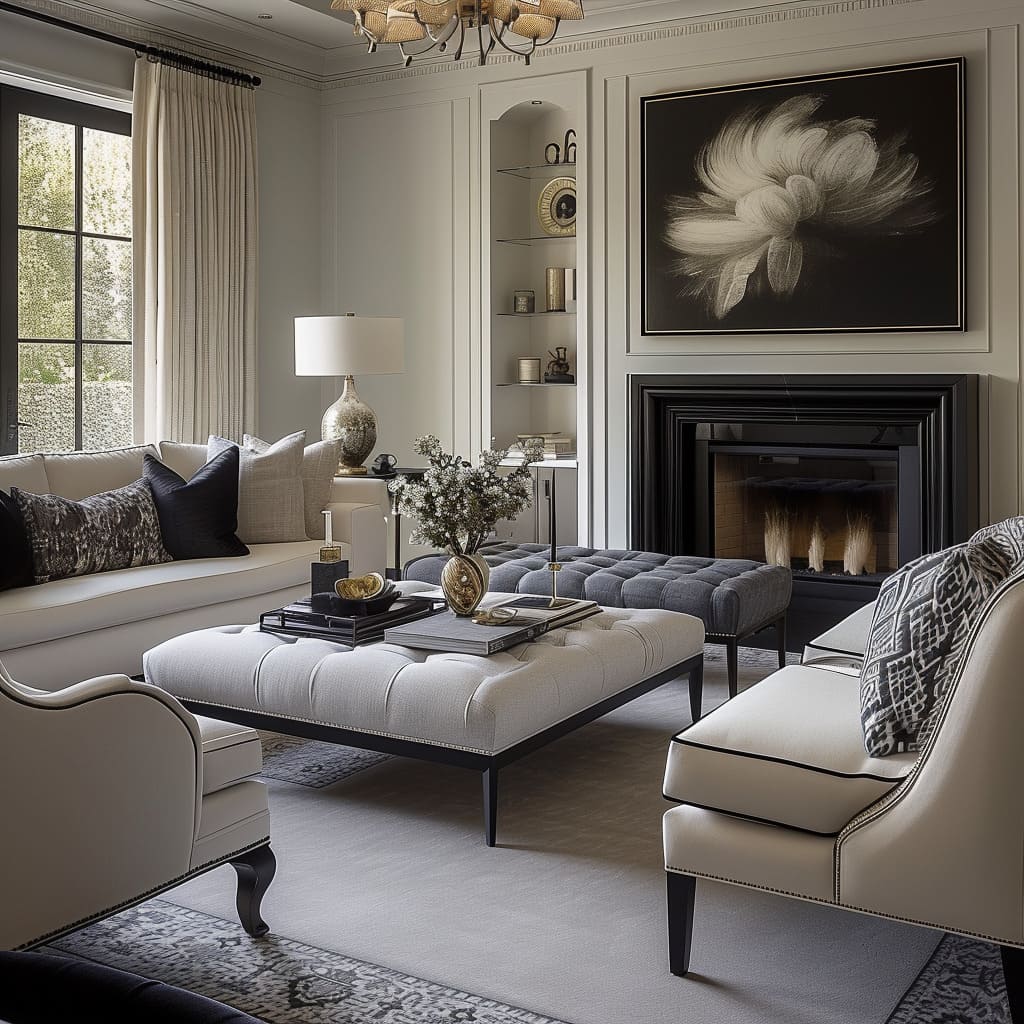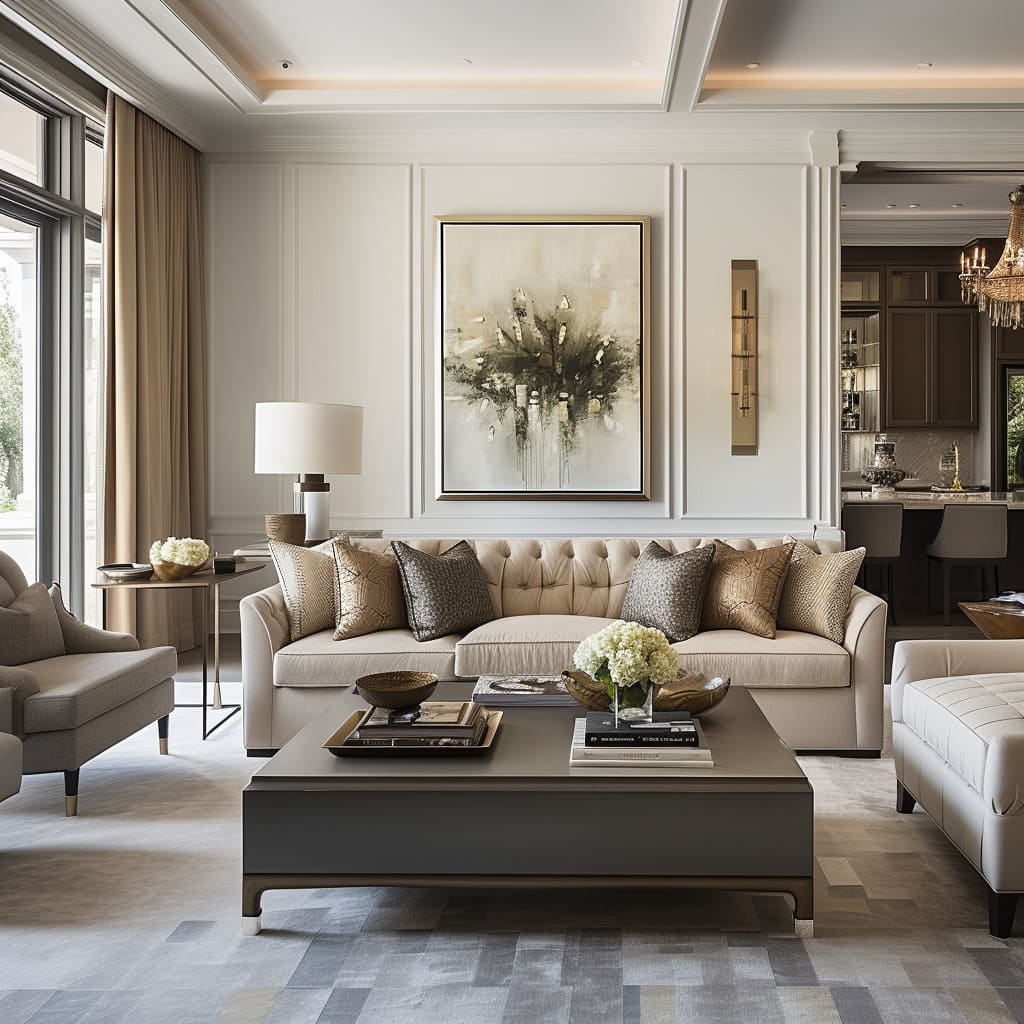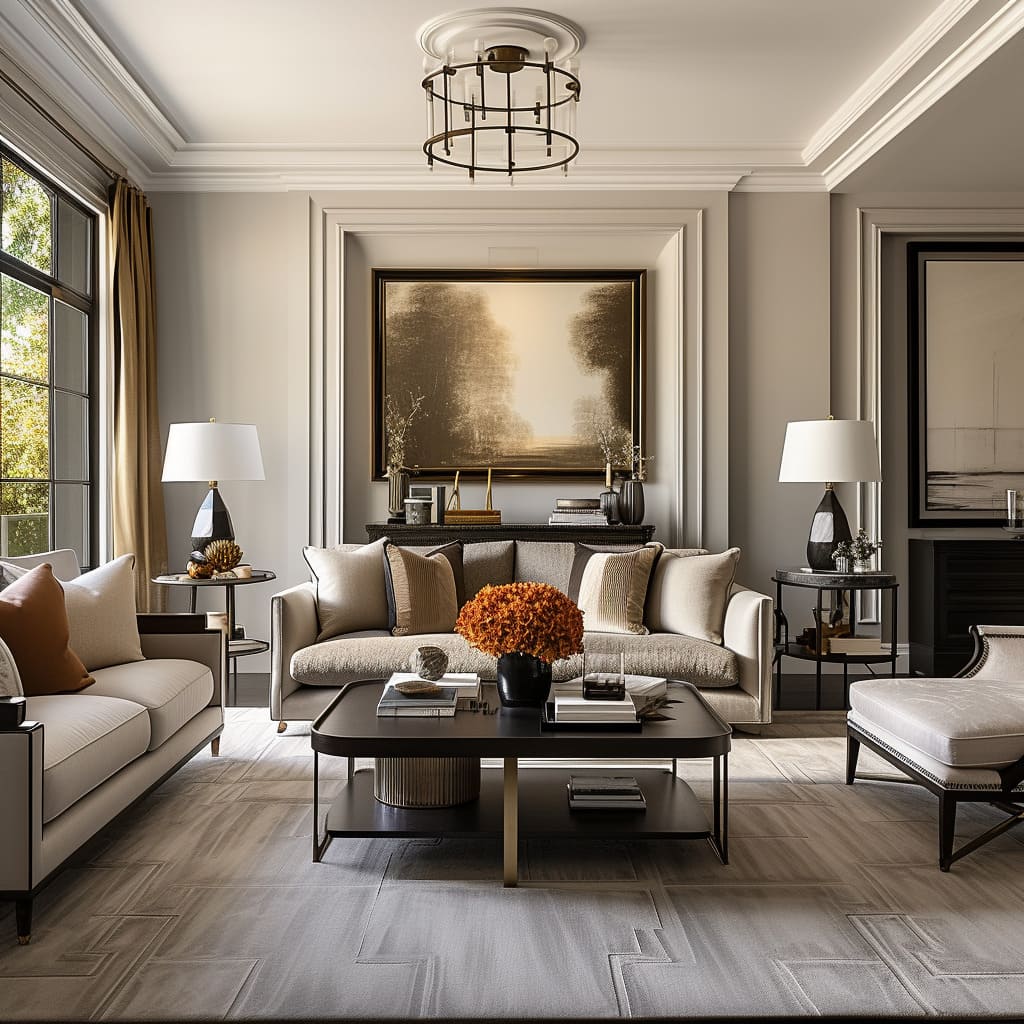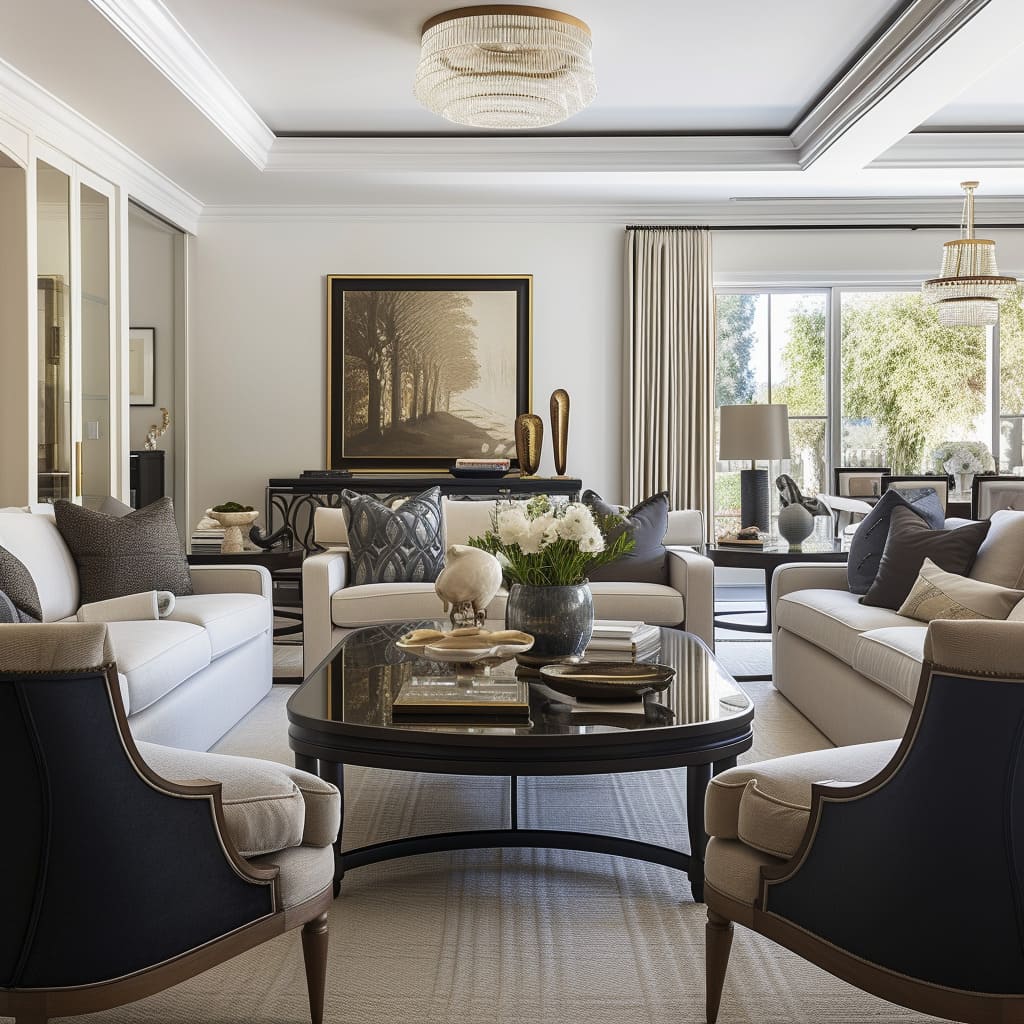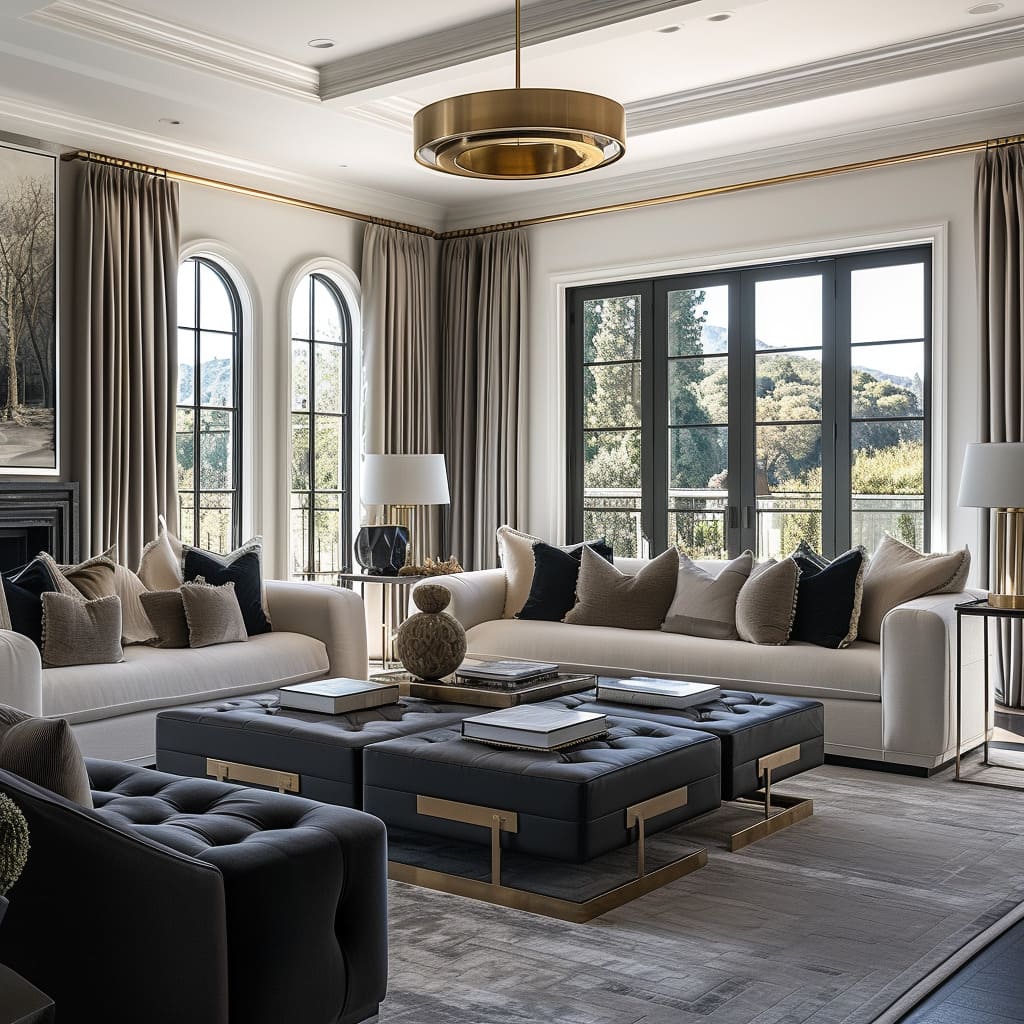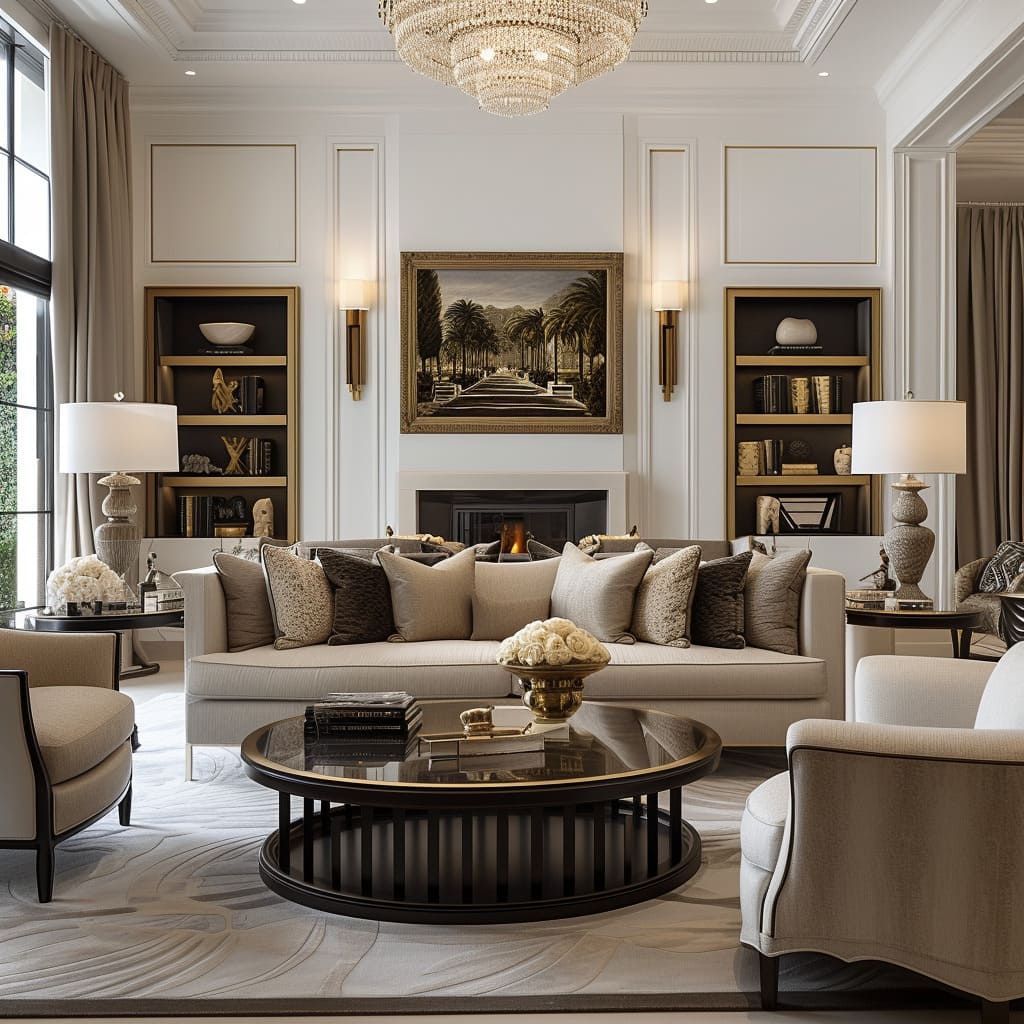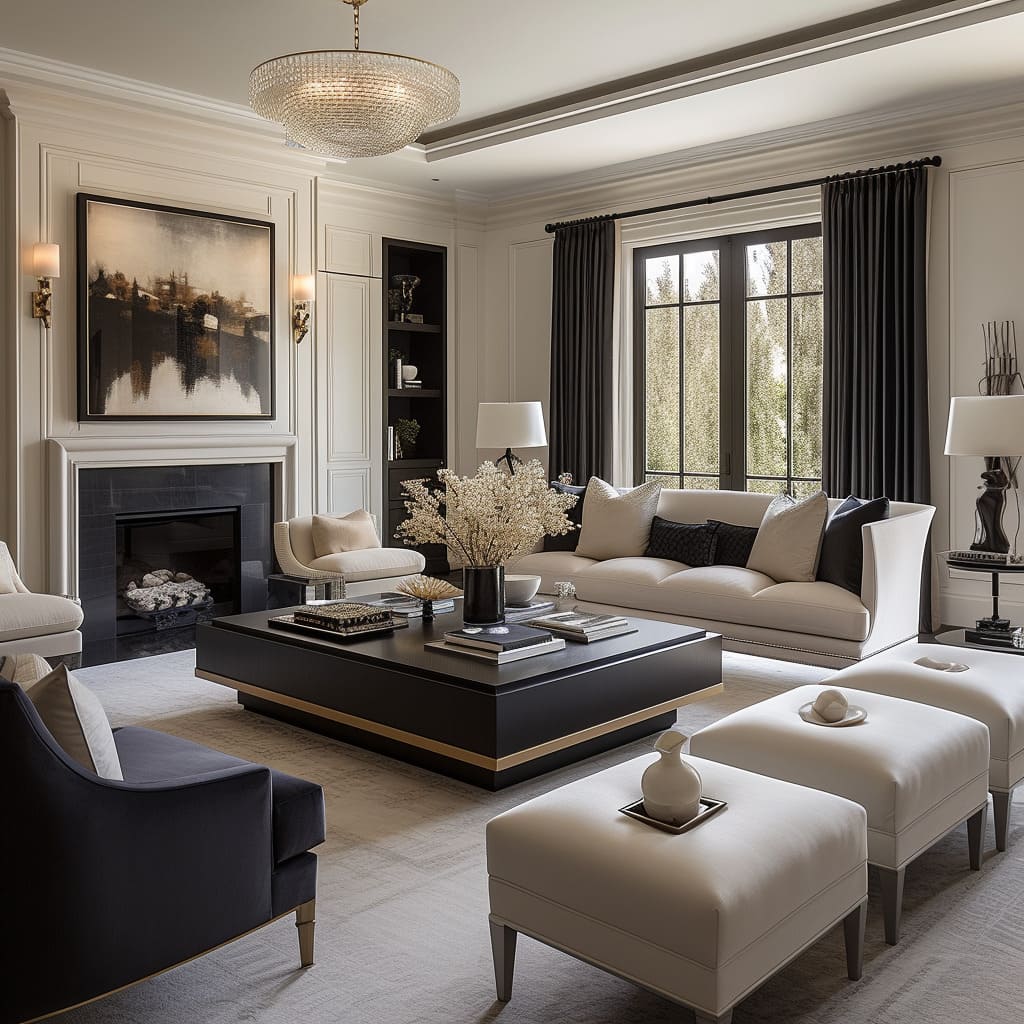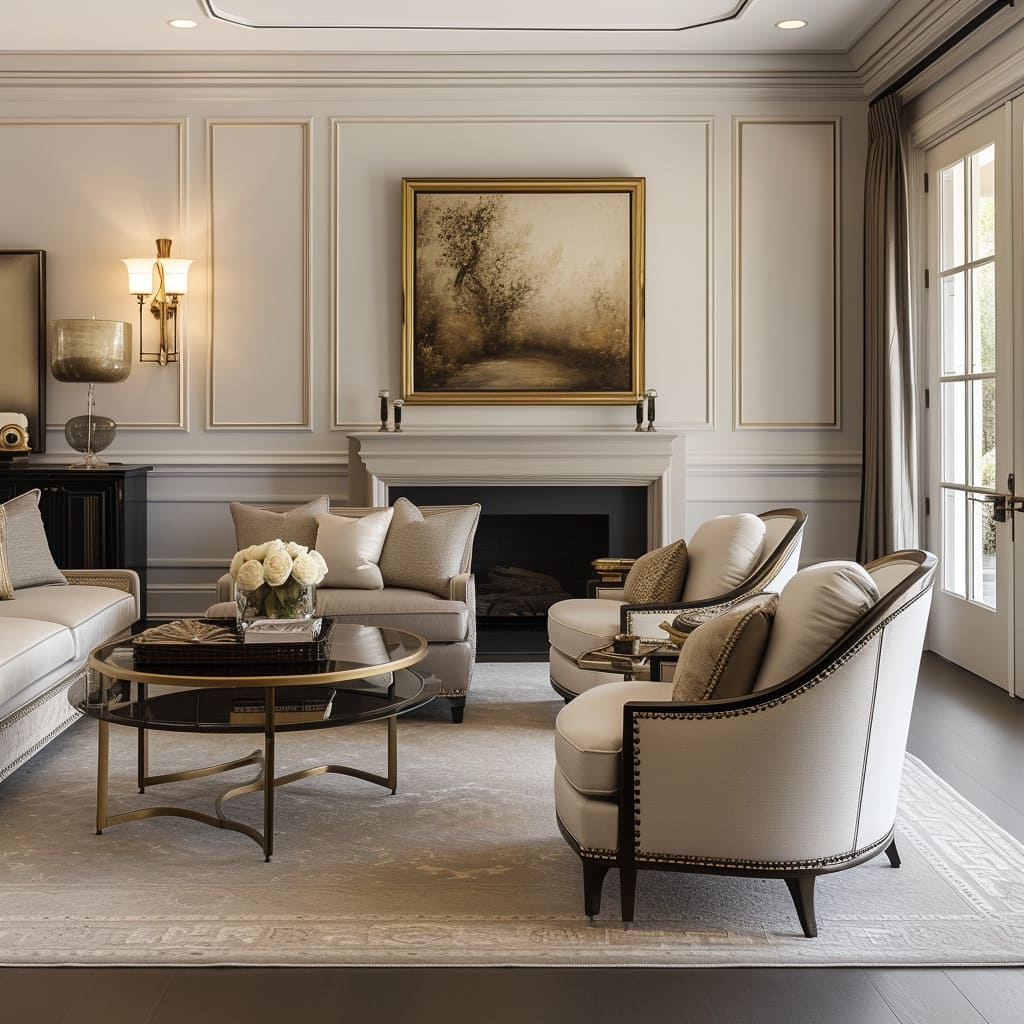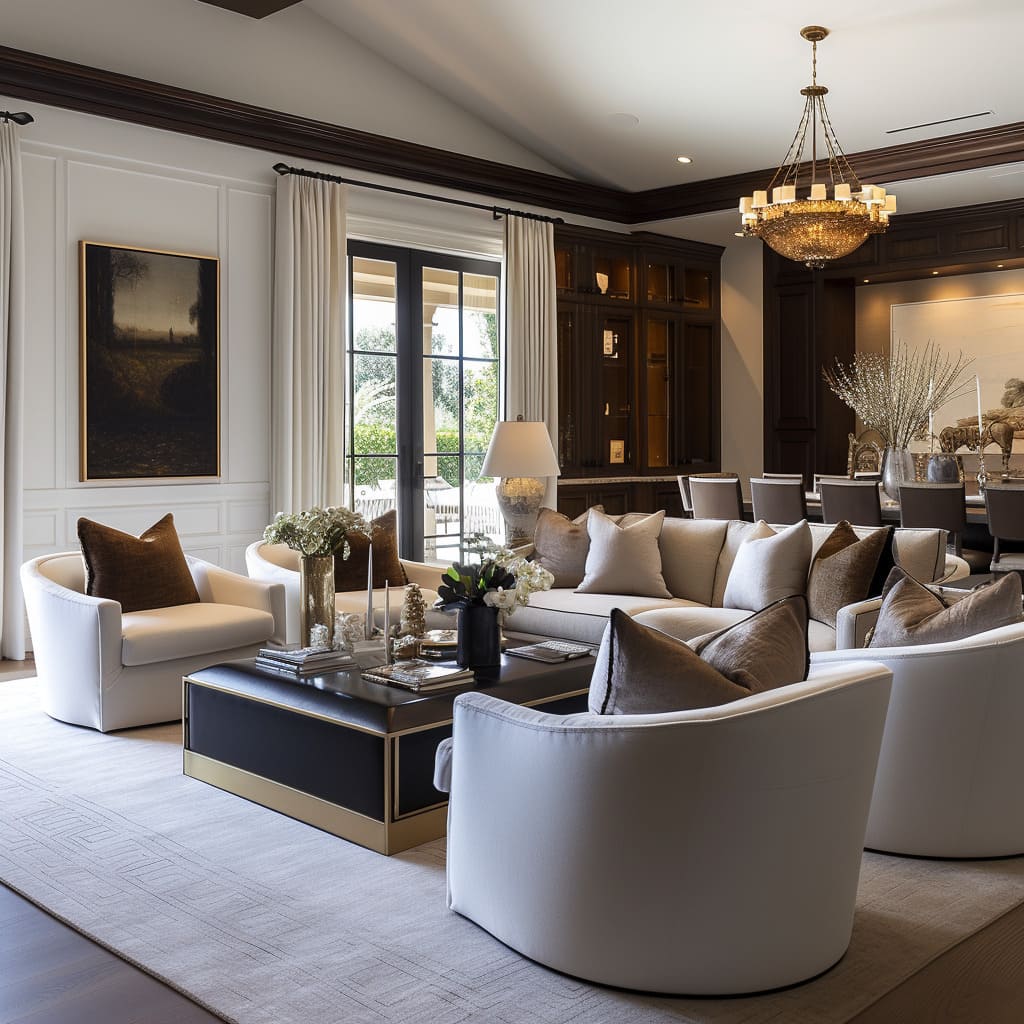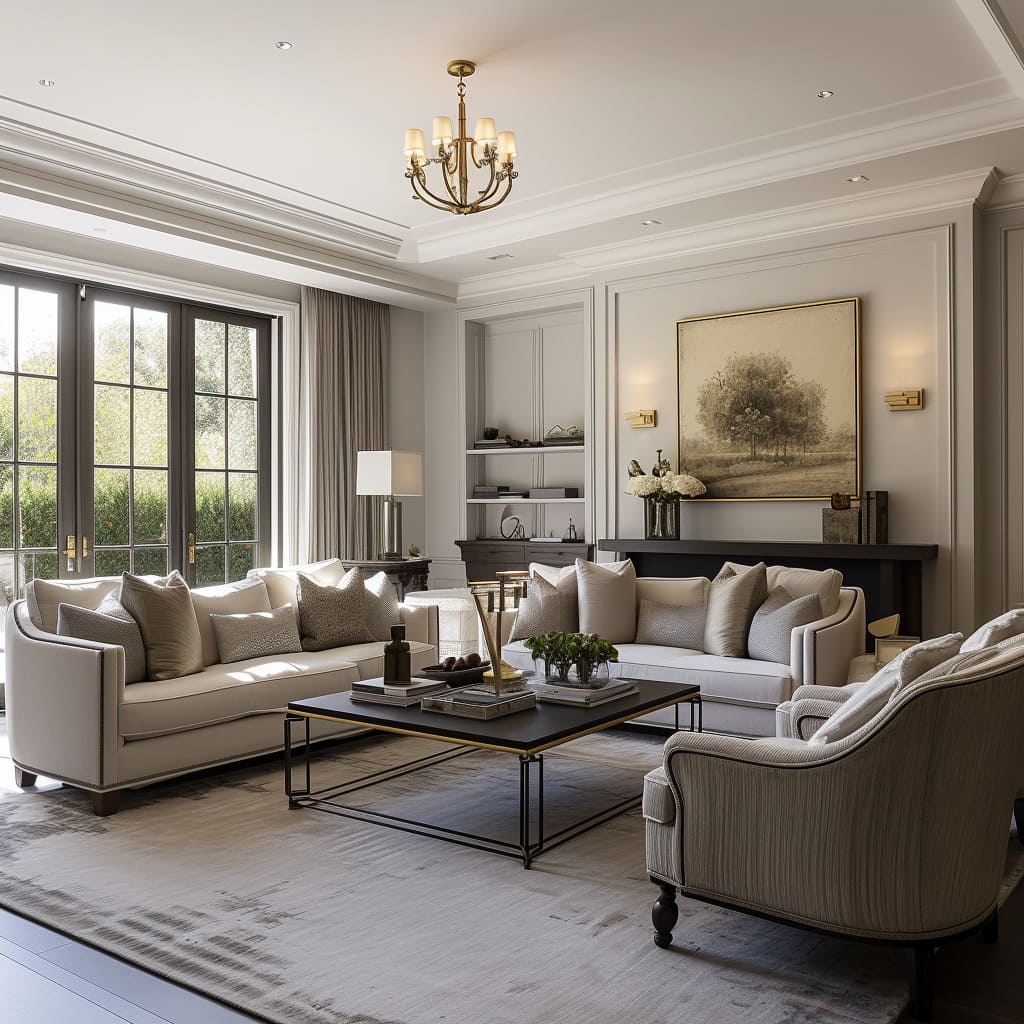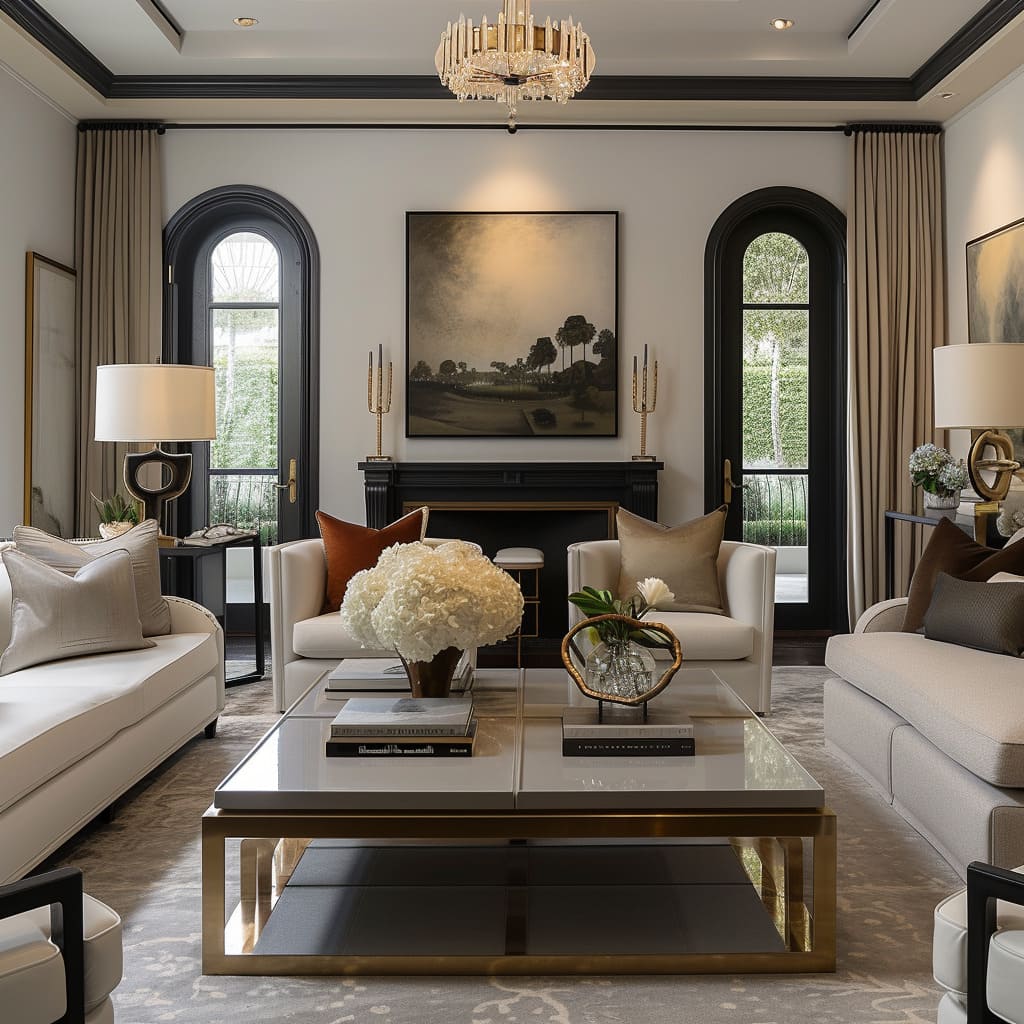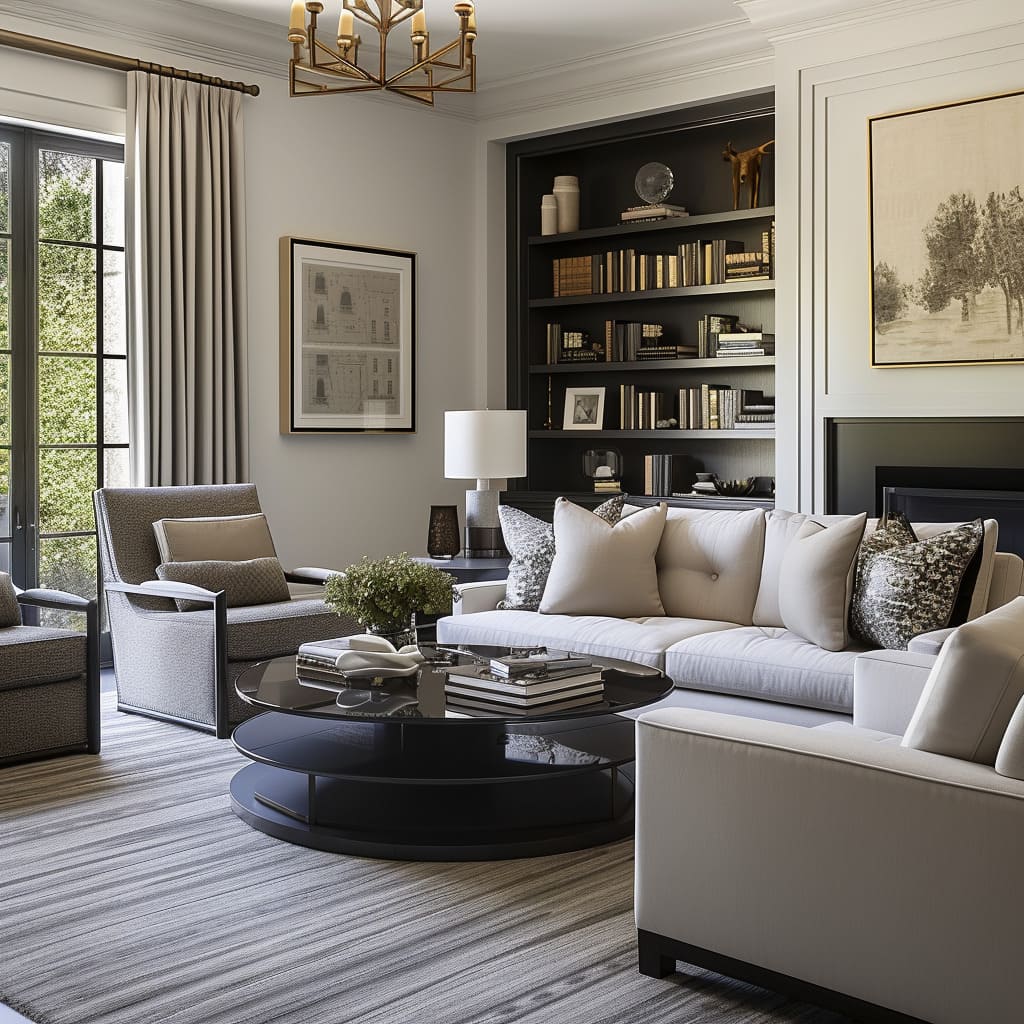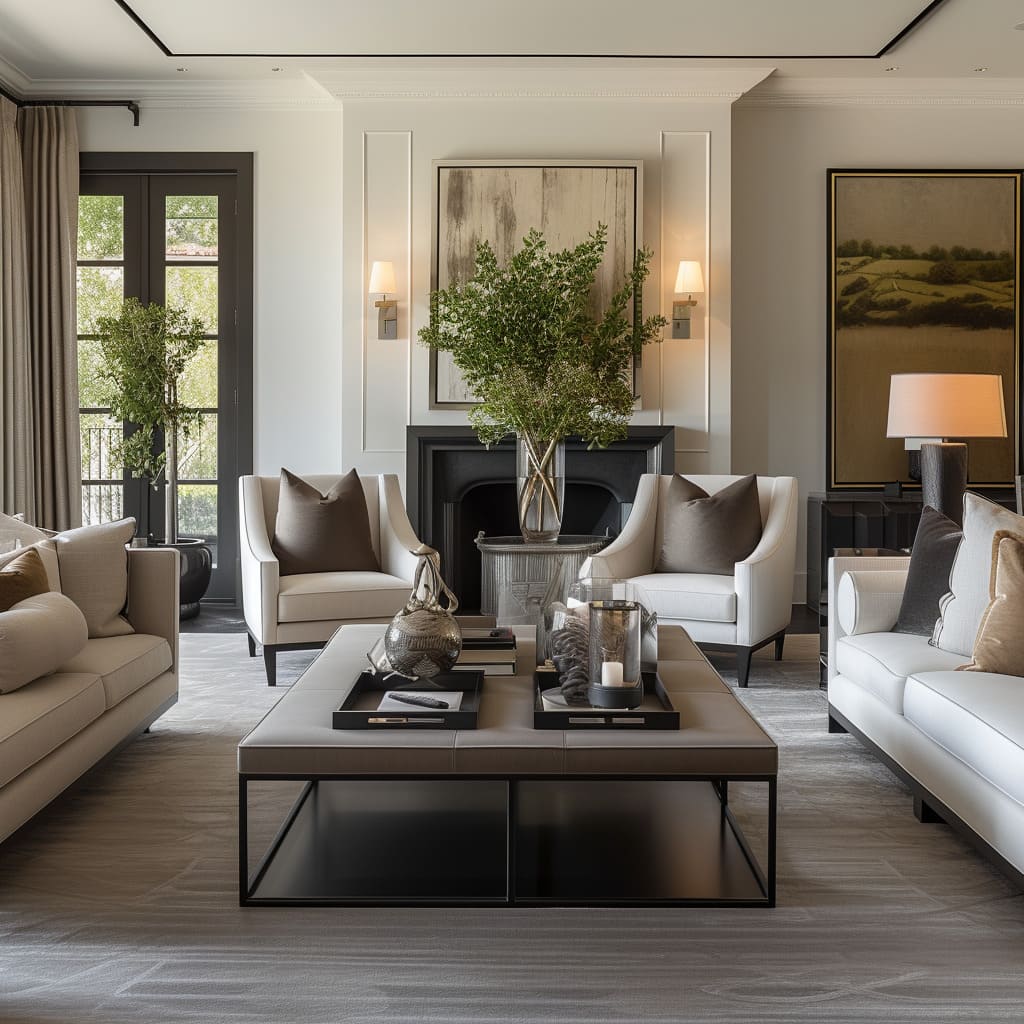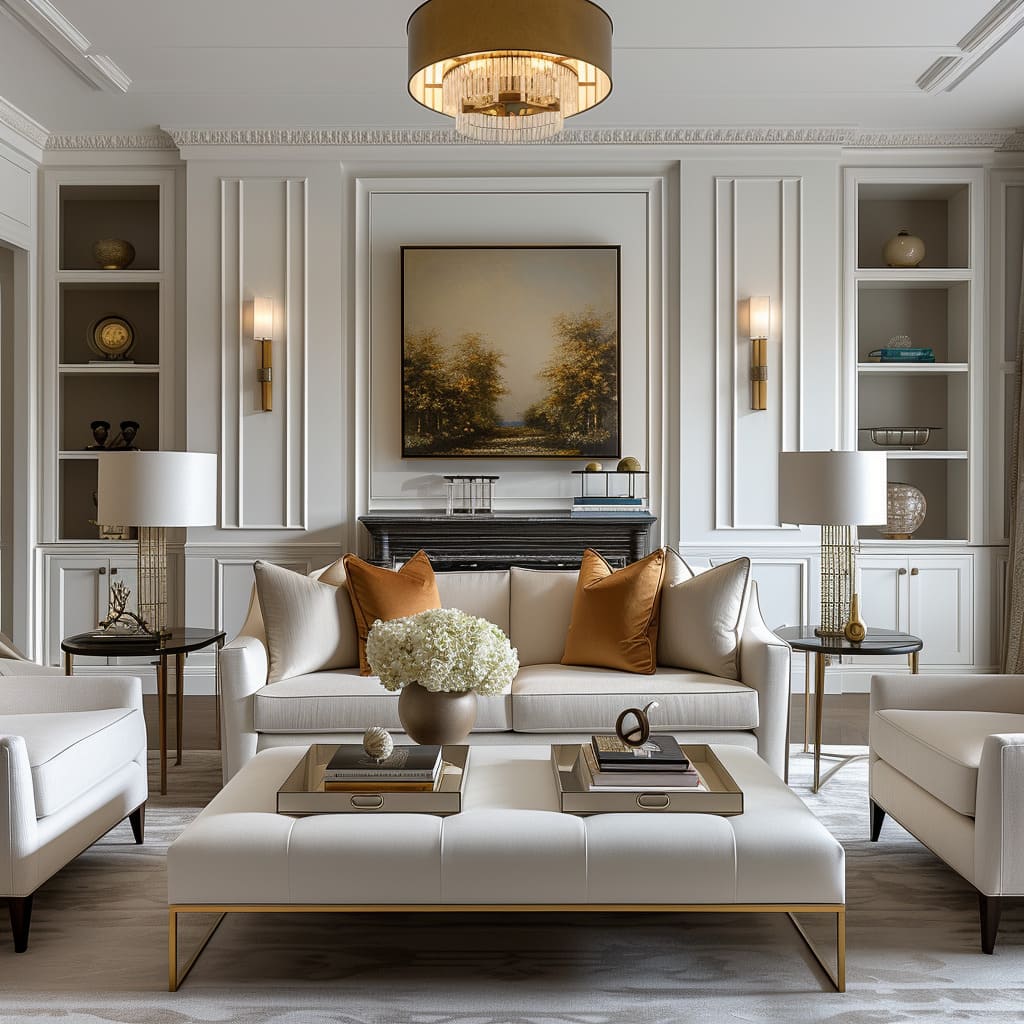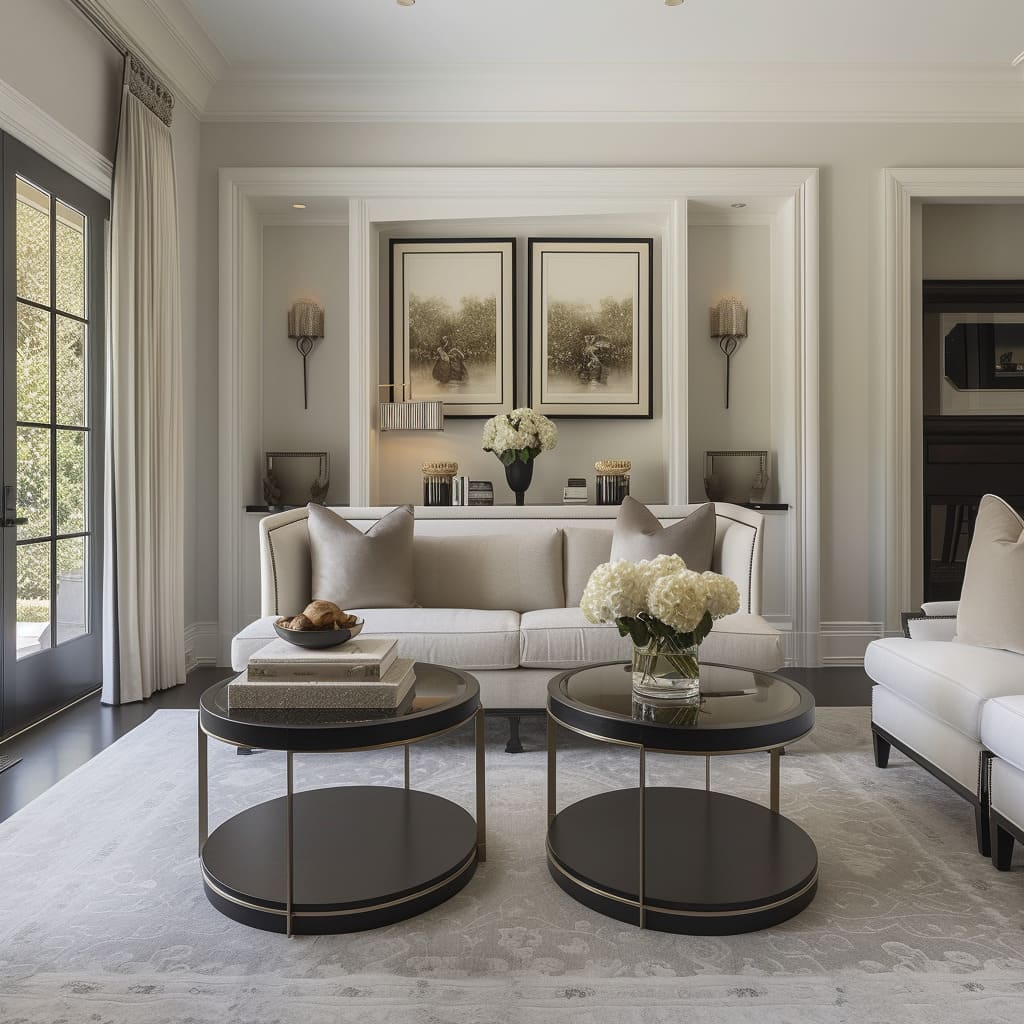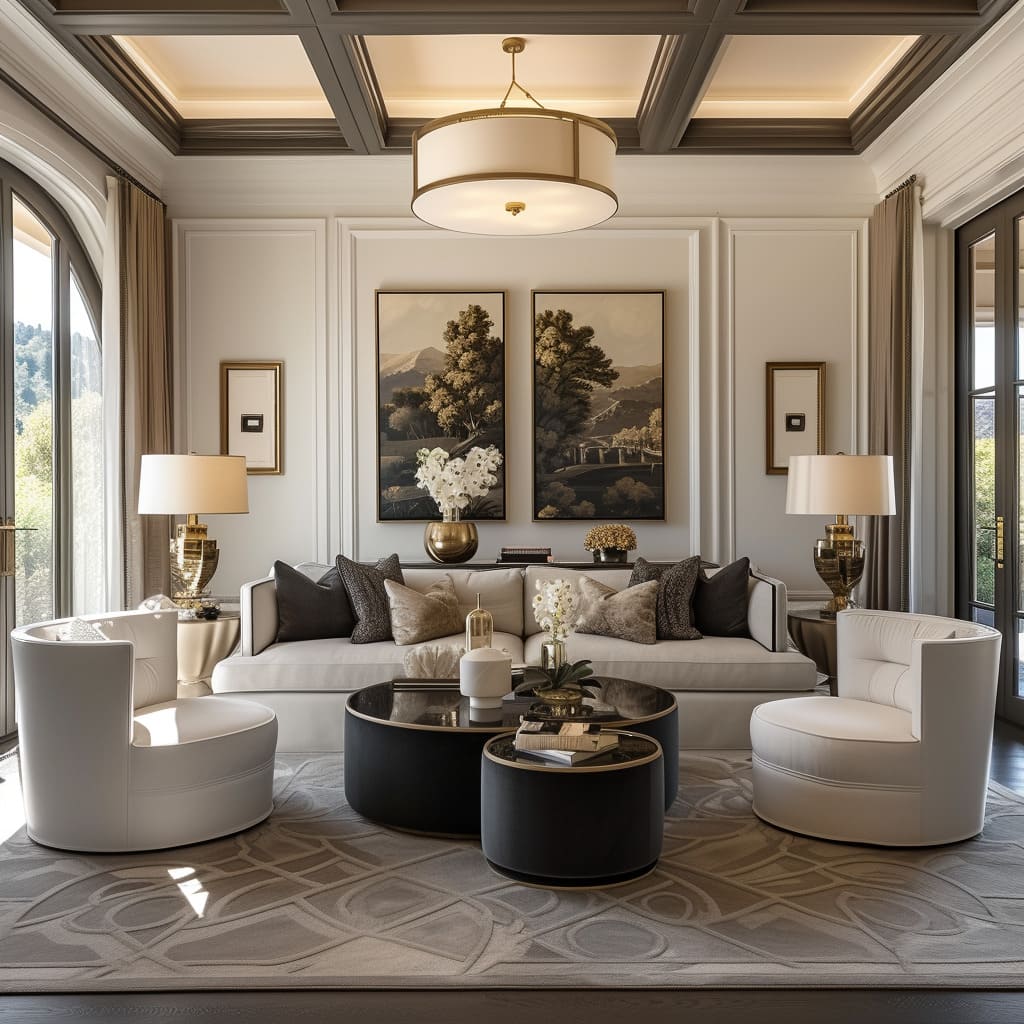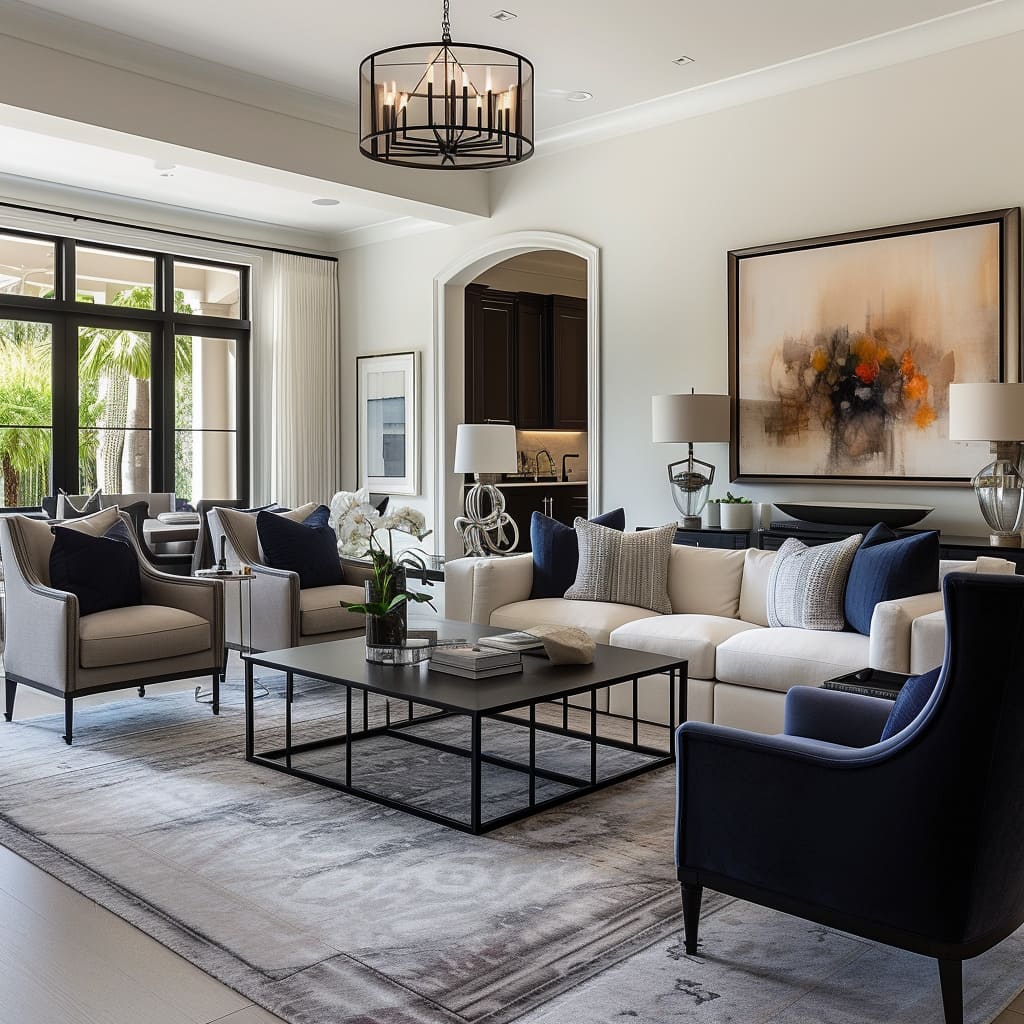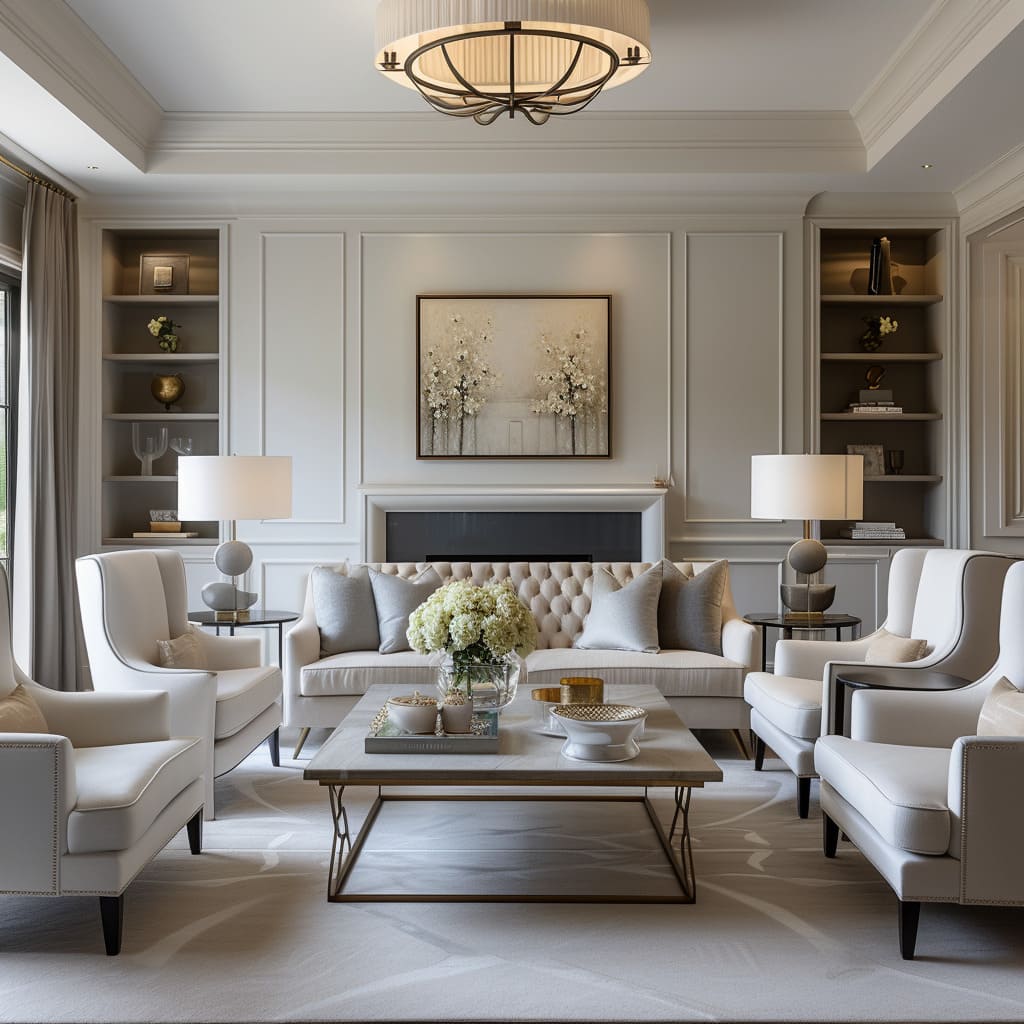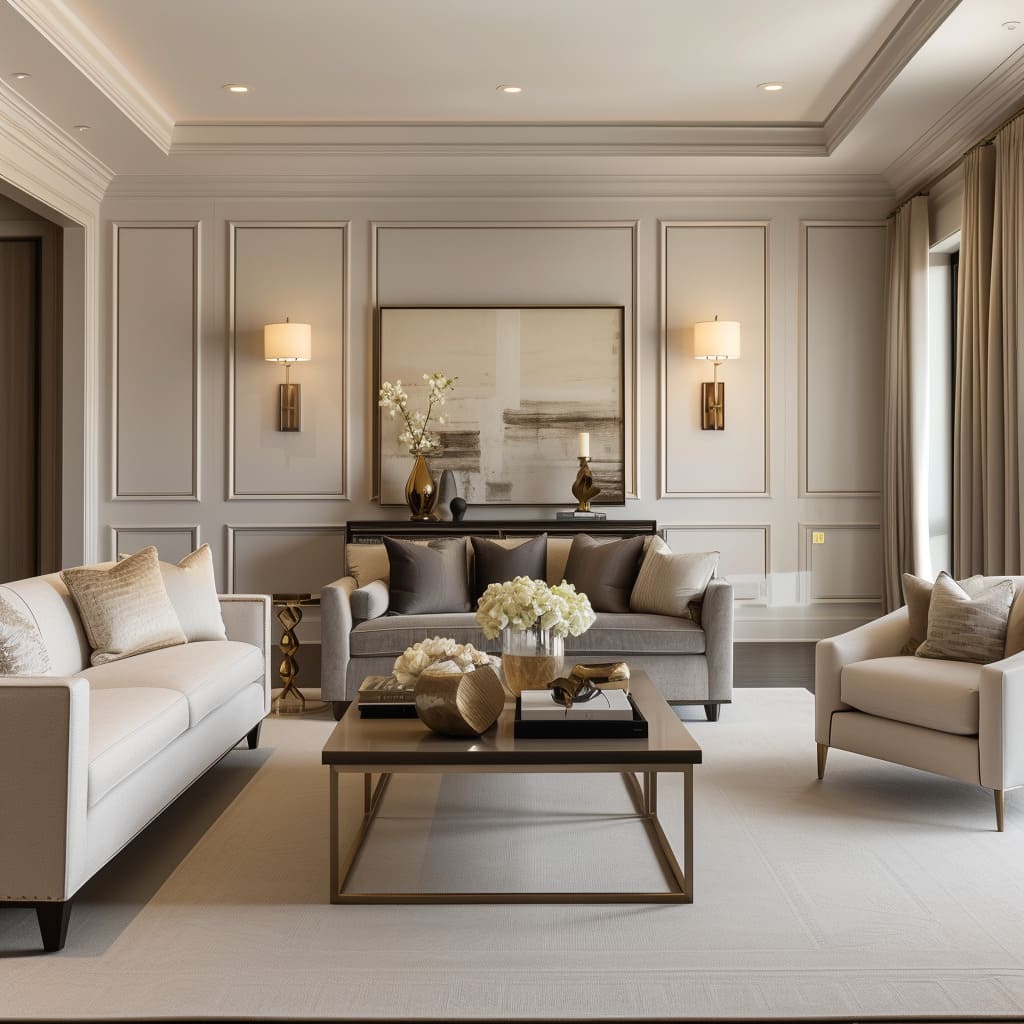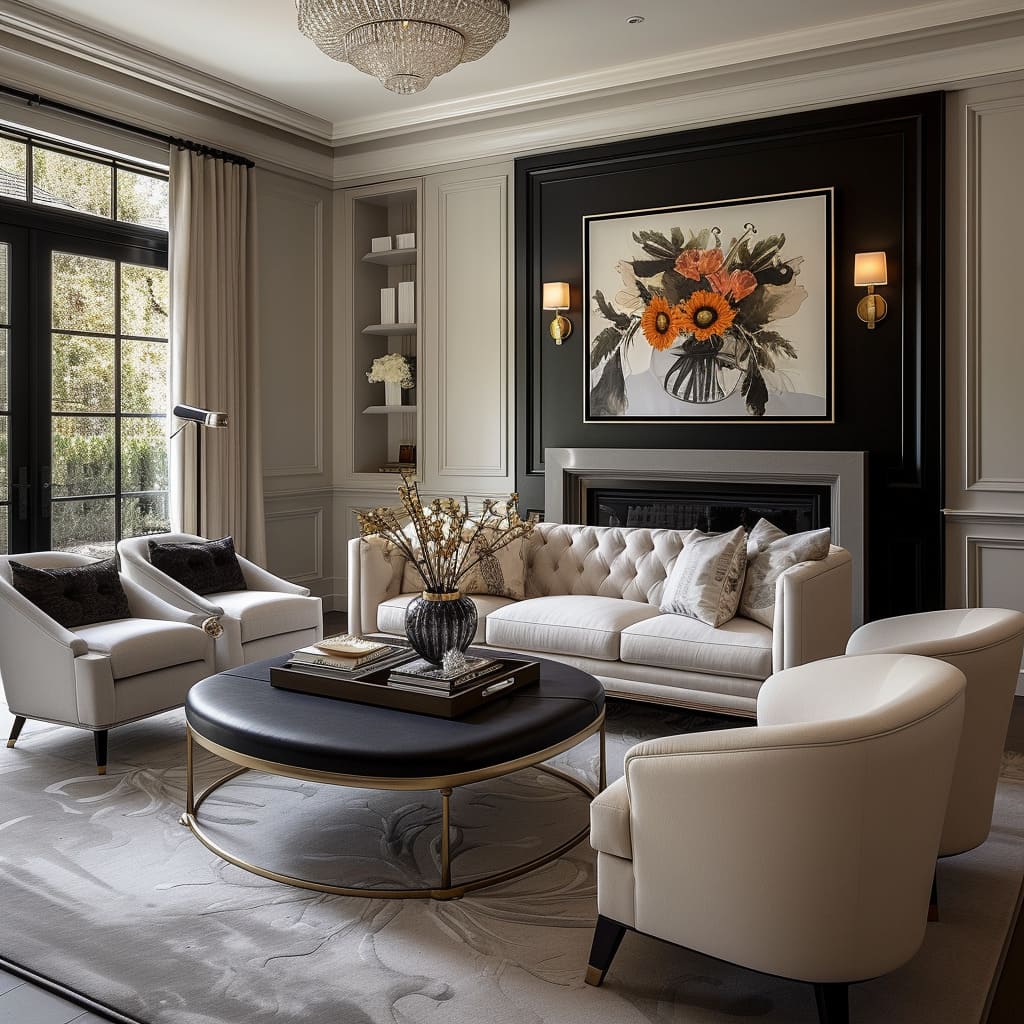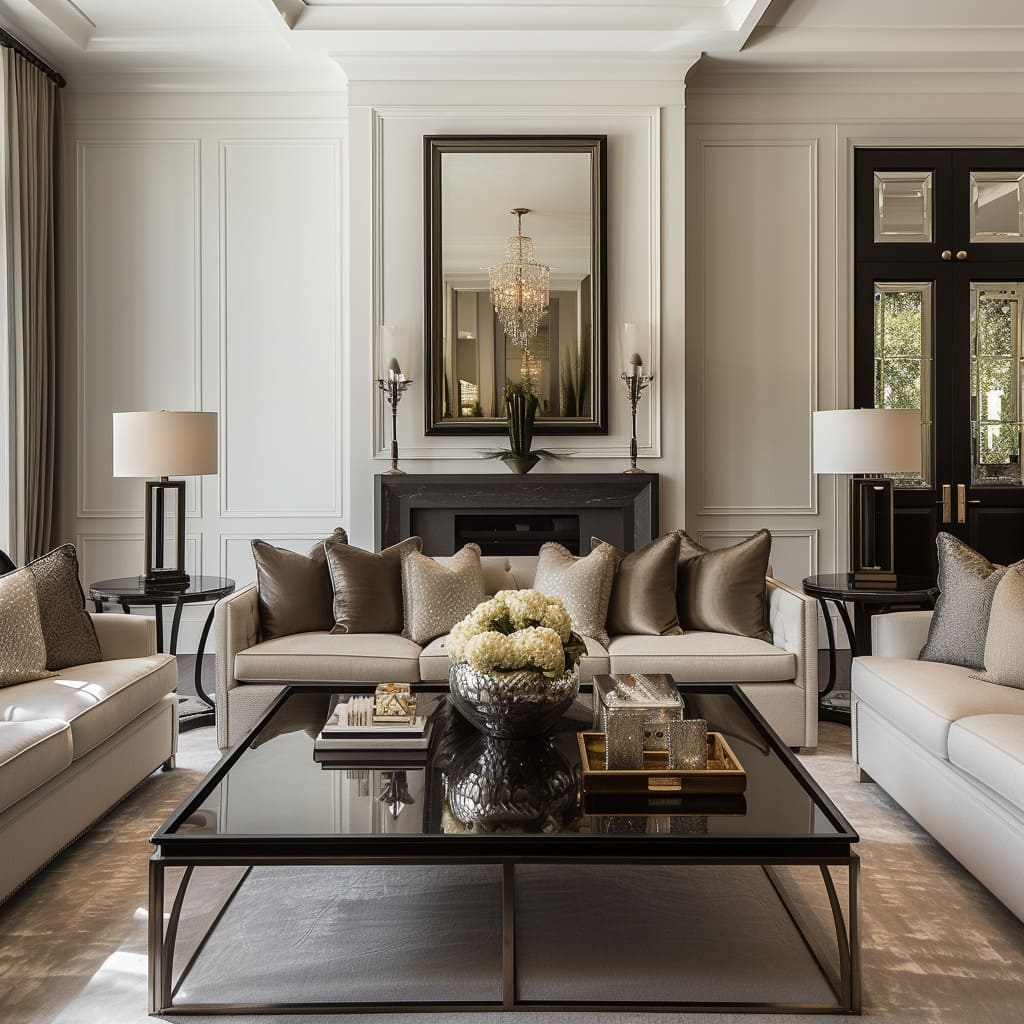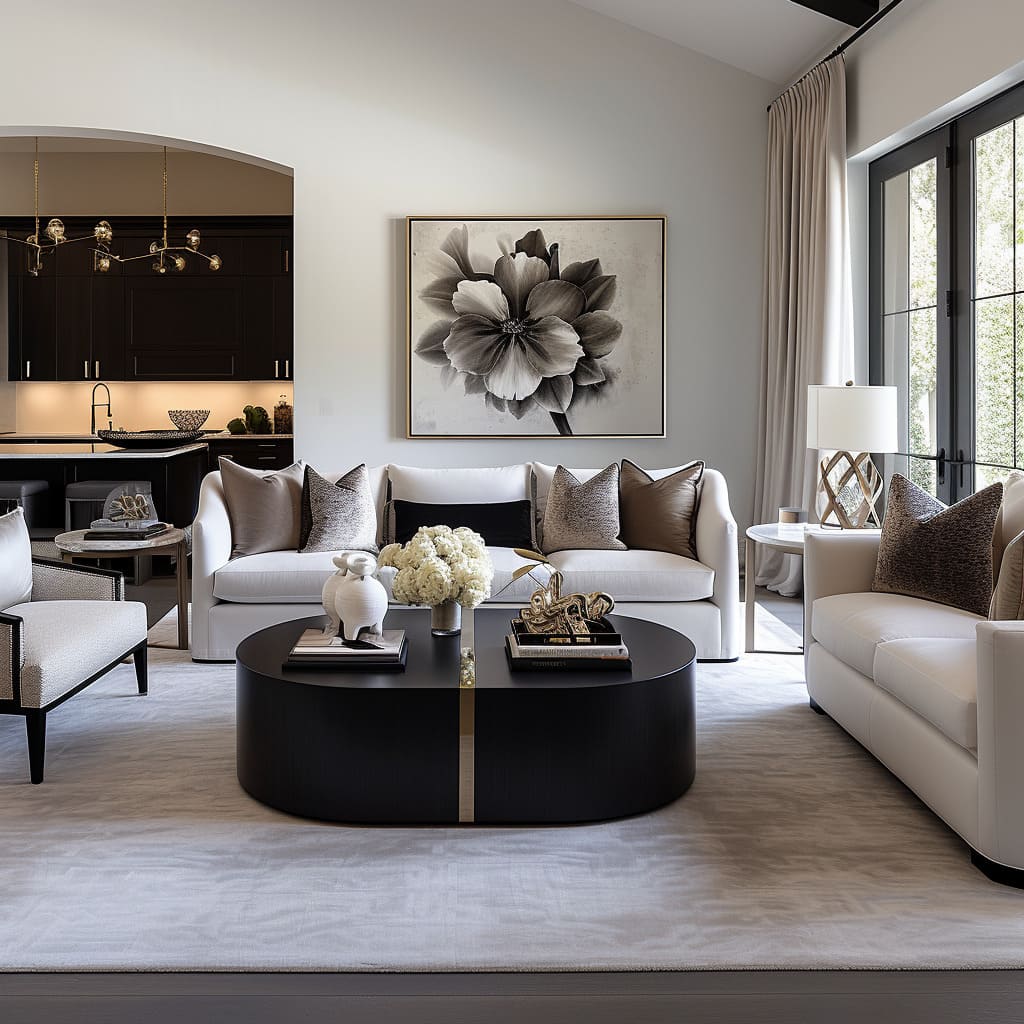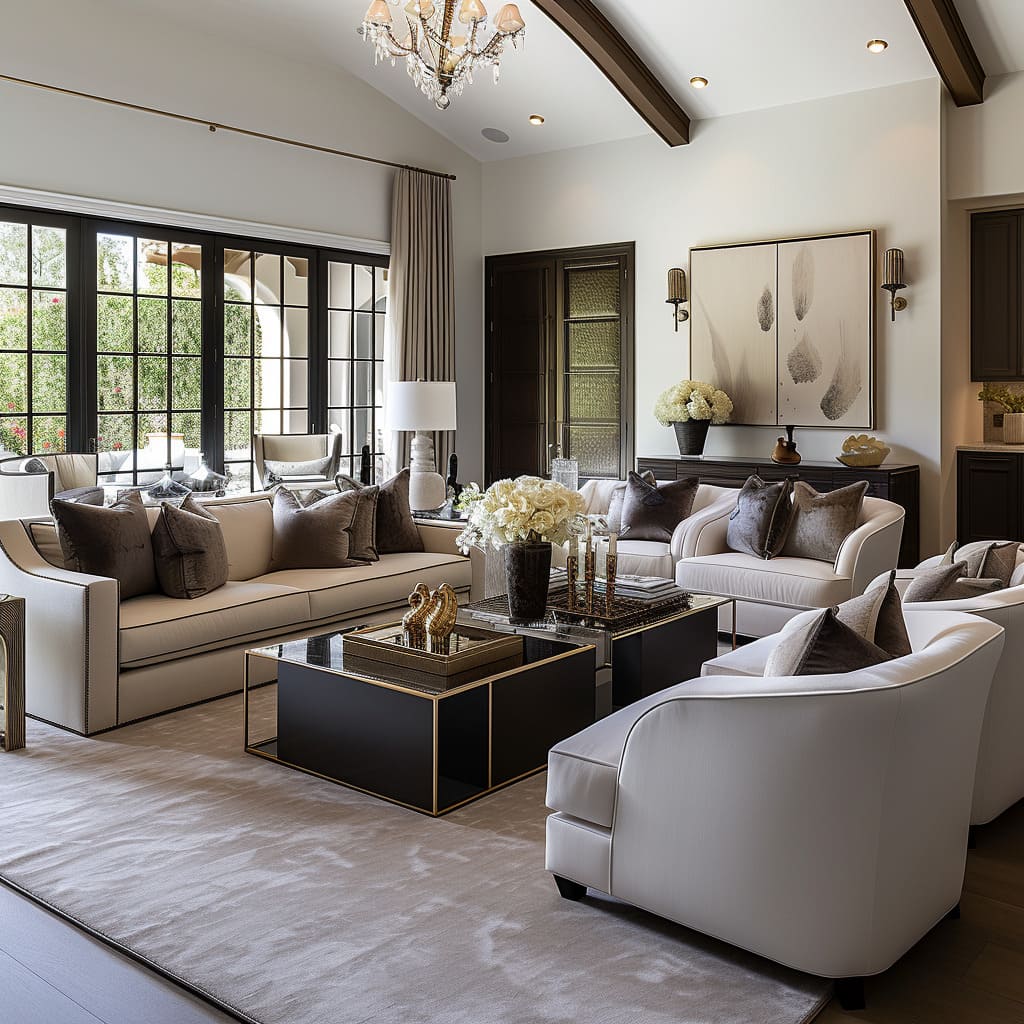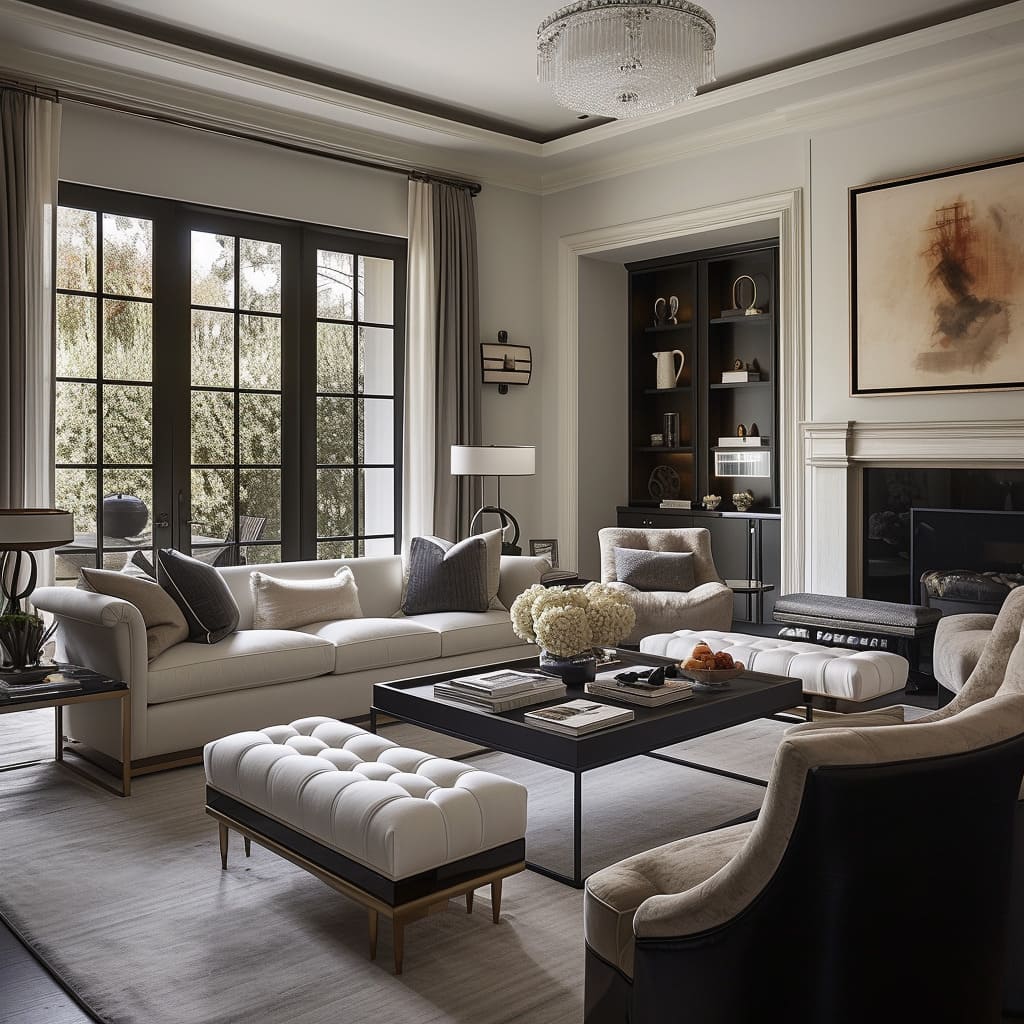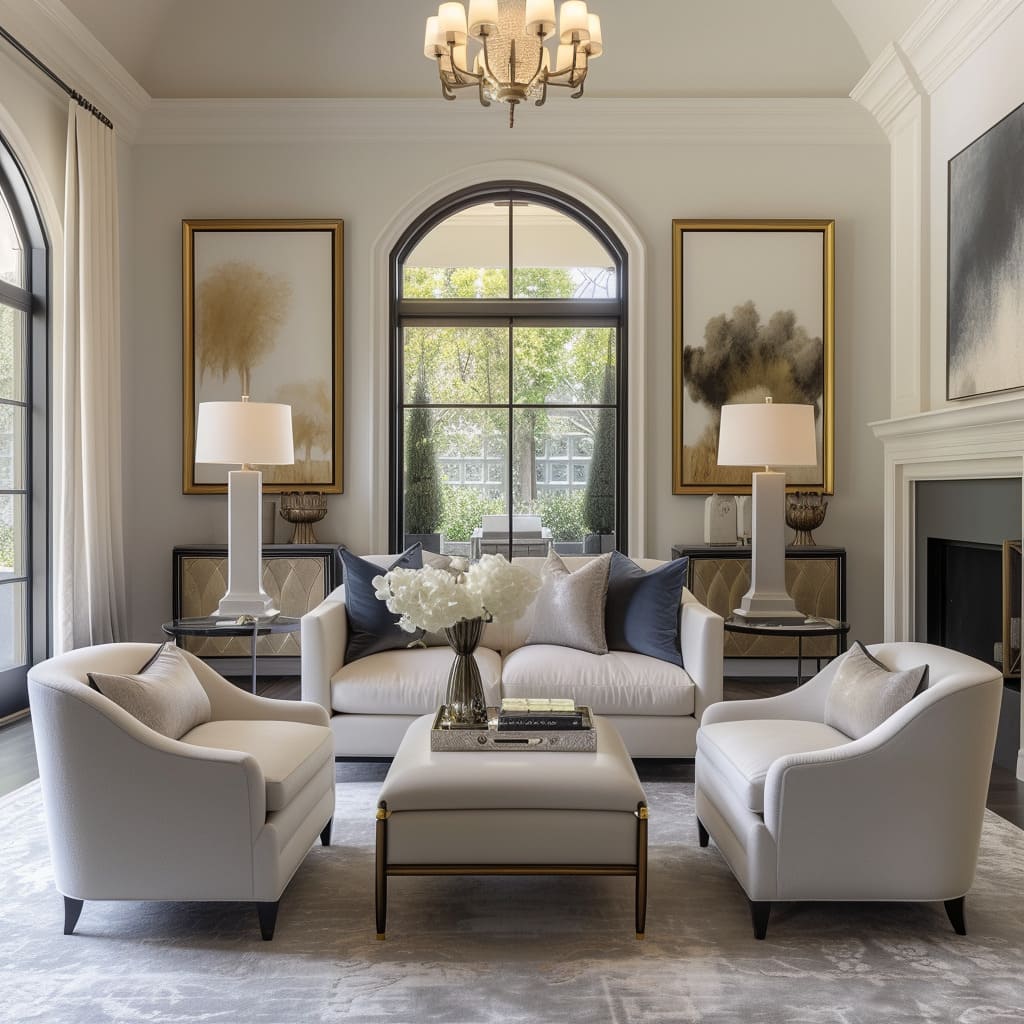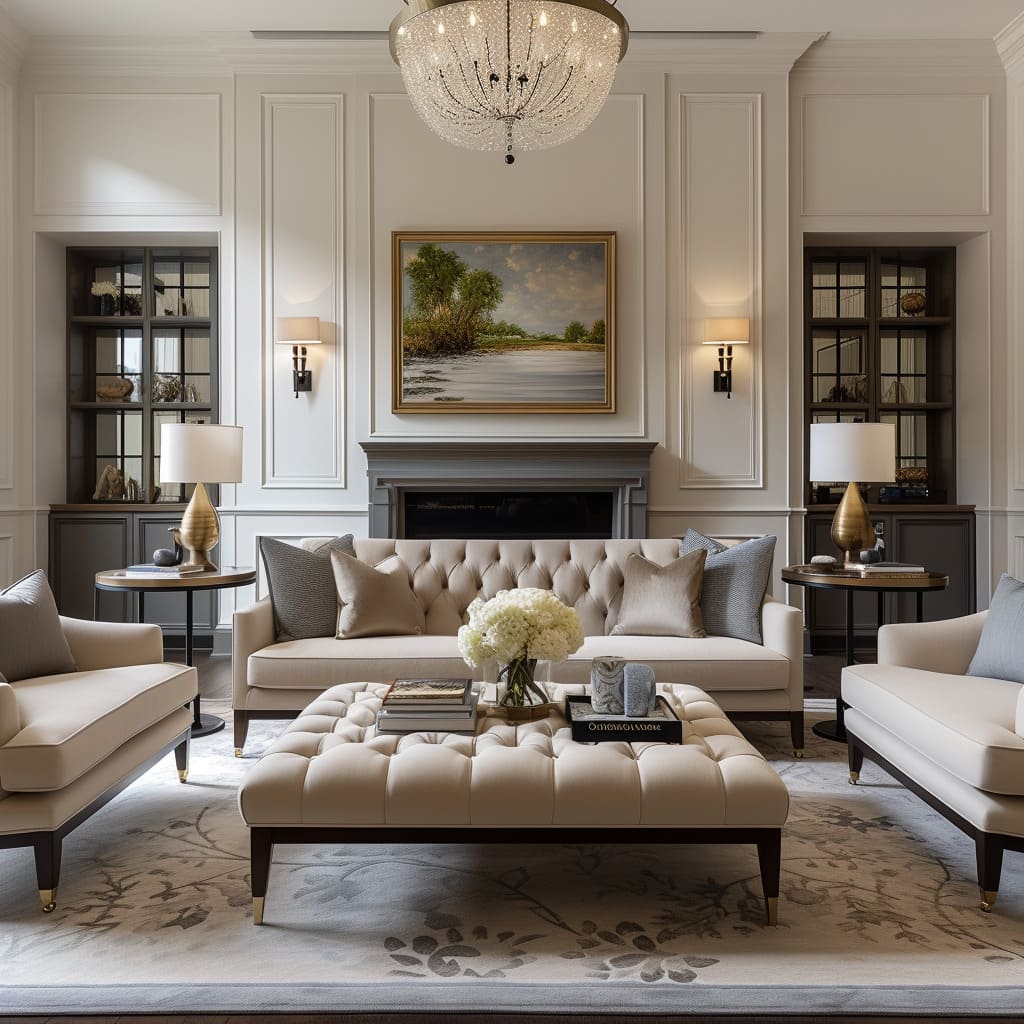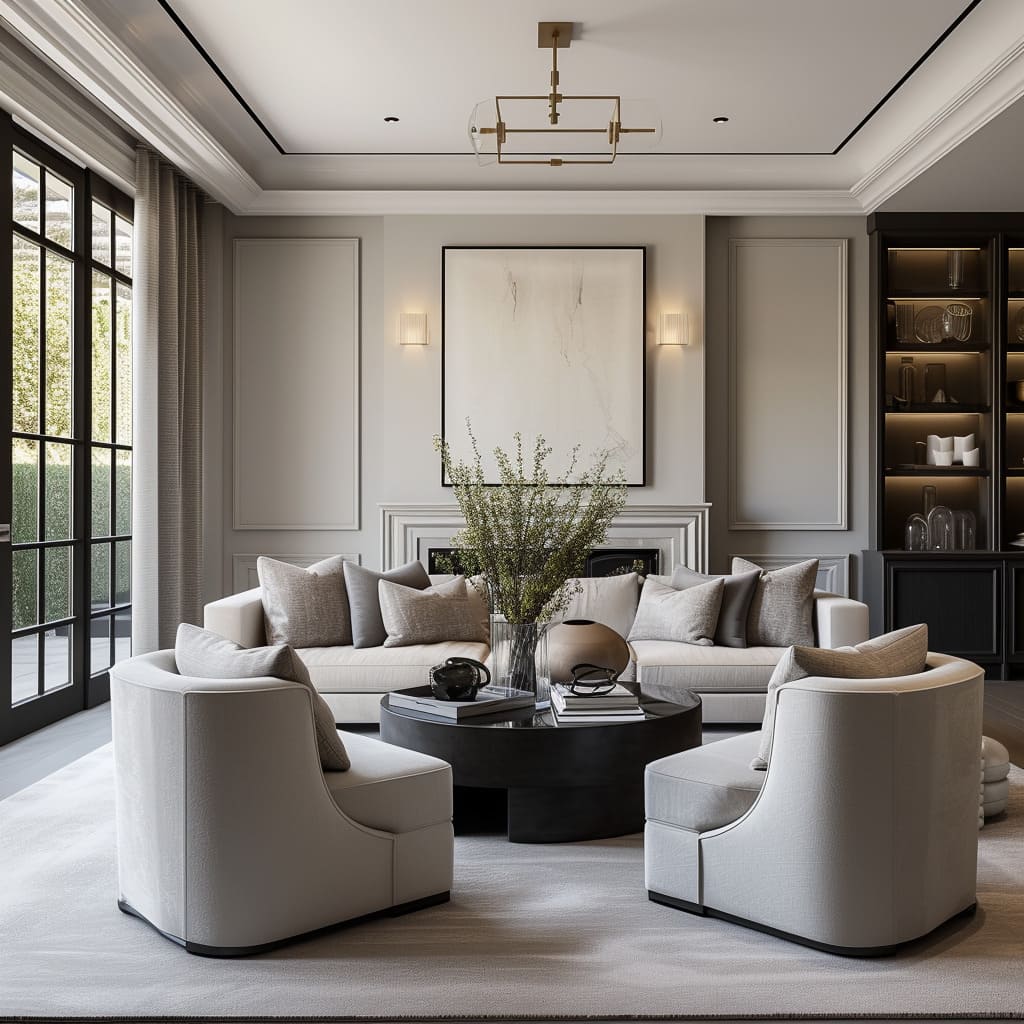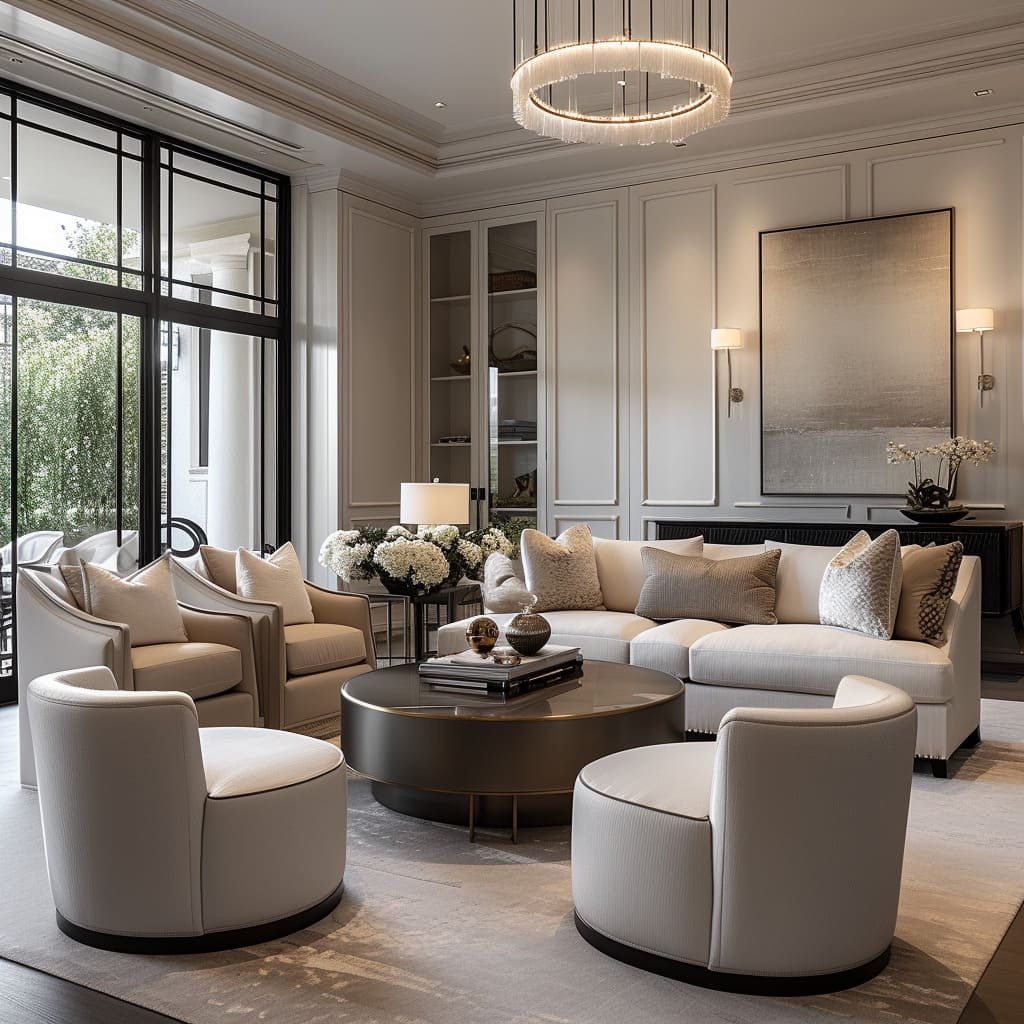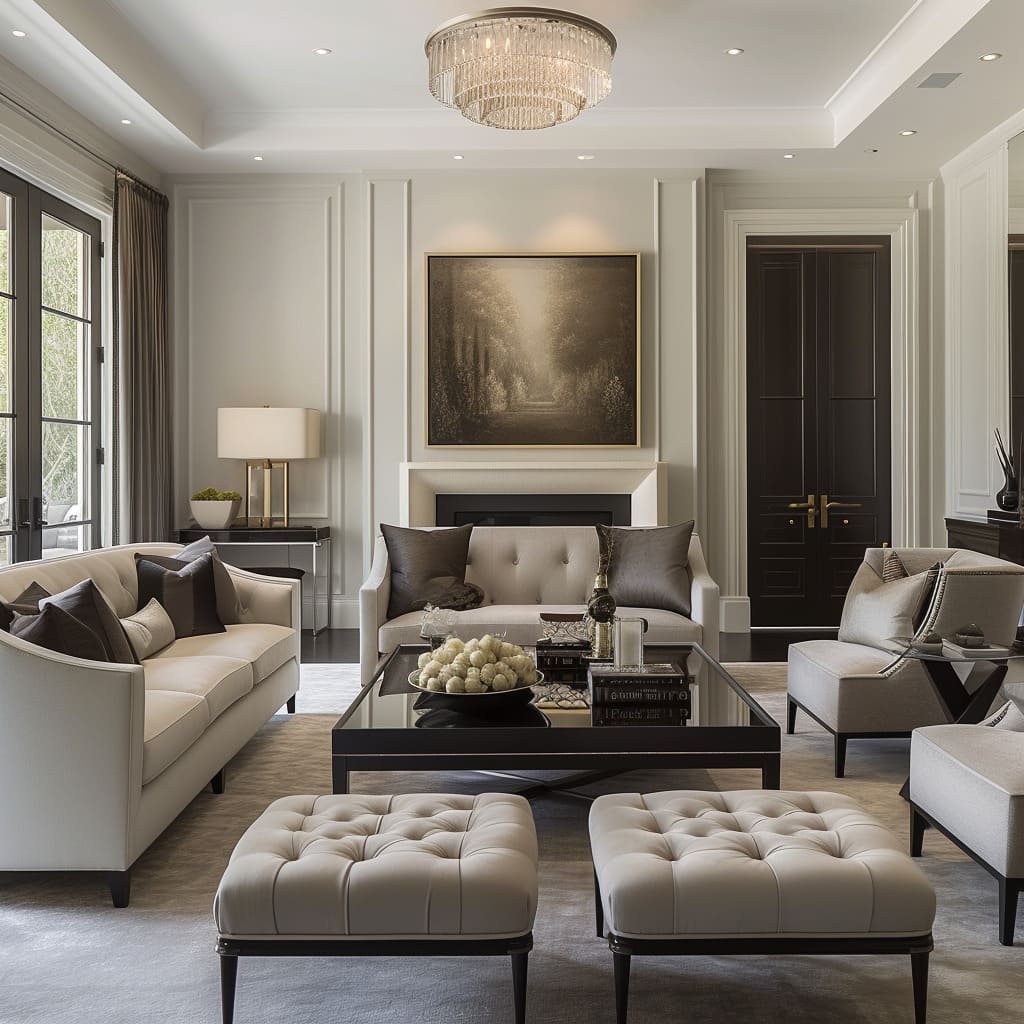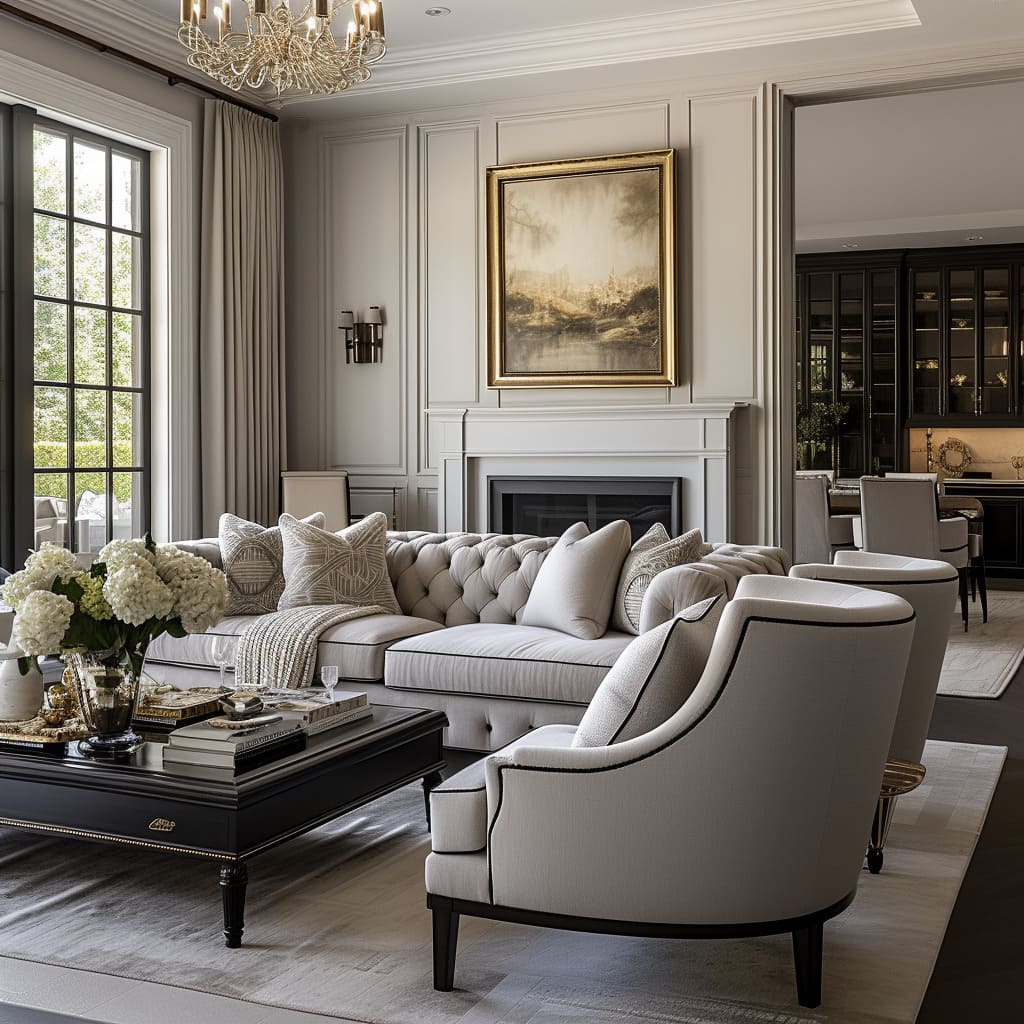In interior design, the harmonious blend of different eras and elements has given rise to the concept of transitional style—a design approach that marries the classic charm of traditional aesthetics with the clean simplicity of contemporary design. This innovative fusion is evident in the way furniture styles are mixed, textures are contrasted, and architectural details are highlighted.Each aspect of the transitional style is carefully chosen to create an ambiance that is both sophisticated and welcoming, balancing the old with the new in a seamless fashion.
Symmetry and Proportion
Transitional design is known for its emphasis on balance and symmetry, which is observed in the placement of furniture and decor. Pairs of lamps, sofas facing each other, and centrally placed artwork contribute to a harmonious and ordered space, which is a principle derived from classical architecture.
This foundational concept is evident in the careful arrangement of seating, the thoughtful positioning of decorative elements, and the strategic use of space to create an environment that feels both unified and inviting. Symmetrical design not only reflects aesthetic harmony but also subconsciously communicates stability and order, essential qualities in a refined living space.
Furthermore, the visual weight of objects and furniture is distributed evenly throughout these rooms, ensuring that each side of the room mirrors the other, not only in layout but also in the style and size of the pieces used.
To realize such balance in your interior, consider the room’s architecture and natural focal points, like fireplaces or large windows, and arrange your furniture accordingly. Utilize pairs of chairs, matching side tables, or twin cushion sets to echo the symmetry on either side of the focal point.The placement of art pieces above a central fireplace or between windows further anchors the room’s symmetry, providing a visual centerpiece that draws the eye and reinforces the classical aesthetic.
The symmetry extends to the smaller details as well. Notice the uniformity in lampshades, cushions, and even the items displayed on shelving – each contributes to the overall equilibrium of the space.When selecting decor, aim for pairs or even numbers, and choose objects that complement each other either by design, color, or size.
Lastly, in a symmetrical room layout, the center of the room can serve as a stage for a statement piece, such as a large coffee table or an ottoman, which not only provides functionality but also serves as a pivot around which the rest of the room is arranged. This central piece can be accentuated with decorative trays, books, or objects that reflect personal style while maintaining the room’s classical symmetry.
Architectural Details
The interiors exhibit classic architectural details such as wainscoting, crown molding, paneled walls, and detailed ceiling coving. These elements add depth and character to the rooms, creating a backdrop that is rich with history and tradition.
The meticulous application of these features draws the eye upward and around the room, providing a visual journey that is both intentional and refined. Each element works in concert to create a dialogue between the architecture and the furnishings, enhancing the overall classical elegance of the space.
The architectural details in these living rooms are not mere afterthoughts; they are integral to the design, framing the space and giving it structure. The wainscoting and paneling, for instance, provide a textured contrast to the soft furnishings and are often painted in muted tones to underline a sense of calm sophistication.Crown molding and ceiling coving create a transition between the walls and the ceiling, adding layers to the room’s dimensions and often featuring intricate patterns that reflect the light in interesting ways.
To incorporate these classical features into your interior, focus on consistency and quality. Choose moldings and paneling that complement the scale of your room—too large and they can overwhelm the space, too small and they may seem insignificant.Paint these details in colors that enhance the feeling of space; lighter hues can make a room feel larger and more open, while darker tones create a sense of intimacy and focus. It’s also worth investing in high-quality materials and craftsmanship, as these details will be a significant part of your interior for years to come.
When integrating these architectural elements, it’s important to consider the overall style of your home. Traditional homes will benefit from more ornate and intricate moldings, while modern homes may call for cleaner lines and simpler details.
However, the key is to maintain a cohesive look that respects the home’s architectural integrity. If you are not able to make structural changes, consider faux panels or stick-on moldings that can mimic the classical look without the need for extensive renovation.Whatever approach you choose, remember that these architectural details are the bones of your interior design, giving it character and elegance.
Rich Materials
The living spaces are a testament to the opulent textures and materials characteristic of classical design. Velvet, silk, and leather are prominent in the upholstery, offering a tactile experience of luxury and comfort.The presence of marble elements or finely polished wood furniture adds a gleaming contrast to the soft furnishings. These materials are not chosen only for their aesthetic appeal but for their enduring quality and the sophisticated ambiance they create.
For those looking to replicate this luxurious feel, incorporating velvet cushions or a leather ottoman can add a touch of sophistication. Choosing a silk throw or high-thread-count linens can bring a sense of indulgence to the room.When selecting furniture, pieces with marble accents or a high-gloss wood finish can elevate the space. The mixture of textures should be balanced to ensure a cohesive look that invites touch and conveys a sense of well-appointed elegance.
The opulent use of materials and adherence to classical design principles in the living spaces evokes a timeless elegance. To achieve such a luxurious atmosphere, consider blending high-quality textiles with durable and classic furniture materials.
Velvet throws or pillows can introduce a soft, plush feel, while leather upholstery adds sophistication and durability. Incorporating a marble-topped coffee table or side tables with a polished wood finish can provide a striking visual contrast, enhancing the overall richness of the space.It’s essential to maintain a palette that complements the textures and to choose pieces that will stand the test of time, both in style and functionality.
Each of these components – symmetry and proportion, architectural details, and rich materials – come together to create living spaces that are not only aesthetically pleasing but also reflective of a storied design history. They offer a blueprint for creating interiors that feel both grand and inviting, a sanctuary of classical beauty.
Mix of Furniture Styles
Transitional interiors skillfully combine furniture of various styles. A classic tufted sofa may sit alongside a sleek, modern coffee table, while traditional wingback chairs might be updated with contemporary fabric.This blend ensures the space feels curated over time rather than matching or overly coordinated.
In these opulent transitional living spaces, the fusion of classic and modern elements creates an atmosphere of refined elegance that’s both timeless and modern. Plush sofas, featuring button detailing and velvety upholstery, provide a nod to the past, while metal-accented furniture and clean lines bring a touch of the contemporary.Notice the strategic use of decorative pillows and throws which introduce color and texture, adding depth and interest to the room.
Incorporating such a mix of furniture styles involves a thoughtful selection of pieces that balance shape, scale, and color. To achieve a similar effect in your own space, start with a neutral base for large items, such as sofas or armchairs.Then, introduce a contrasting style with your choice of tables or accent furniture. For example, pair a traditional rolled-arm sofa with a minimalist glass-top coffee table.The key is to maintain a cohesive color palette and to balance the visual weight of the pieces, ensuring that no single item overwhelms the space.
For a personal touch, consider reupholstering a classic piece with a modern fabric or adding contemporary art above a traditional fireplace. Accessories and lighting are also critical; choose lamps with clean lines or shades that reflect the room’s blended styles.Remember, transitional design is all about the harmonious and balanced coexistence of diverse design elements, brought together to create a seamless and sophisticated look.
Textural Contrast
There’s an emphasis on texture, with a range of materials from smooth glass and metal to nubby fabrics and grainy wood. Decorative pillows, throws, and rugs introduce a tactile dimension that invites touch and promotes comfort.
The carefully curated living spaces exemplify textural contrast through the meticulous placement of various materials. Gleaming metal accents on tables and lighting fixtures add a sleek edge to the rooms, while the matte finish of clay vases and the soft sheen of polished wood provide a subtle interplay of surfaces.Textural variety is further enhanced by the strategic layering of rugs, some with a high pile that begs to be walked on barefoot, and others with intricate weaves that catch the eye.
To infuse a sense of textural richness into your home, start by selecting a foundational texture that reflects your overall aesthetic—be it the smoothness of leather or the warmth of wood. Layer this with contrasting elements, such as a shag rug atop a hardwood floor or heavy drapes against a minimalist backdrop.Accent pieces like hammered metal bowls or velvet cushions can act as focal points, drawing attention and inviting interaction.
For a cohesive look, maintain a consistent color scheme that ties the different textures together. Neutral tones can act as a canvas for texture play, allowing the varied surfaces to stand out without clashing.The use of organic materials, like a stone fireplace surround or a live-edge wooden table, can add an unexpected and earthy texture that complements more refined surfaces. Remember, the goal is to create a space that appeals to the senses, combining visual interest with tactile appeal to create an environment that’s both inviting and dynamic.
The transitional style’s unique ability to combine various elements from different design traditions results in a living space that is both timeless and current. It respects the craftsmanship and richness of classical design while embracing the minimalism and comfort of the modern age.
The mix of furniture styles, the interplay of textures, the symmetry and balance of the layout, the emphasis on architectural integrity, the elegance of the lighting, the luxury of rich materials, and the subtlety of the color palette all contribute to creating an interior that is as functional as it is beautiful. Transitional design, therefore, stands as a testament to the idea that in diversity there is beauty, and in the blending of styles, there is harmony.


